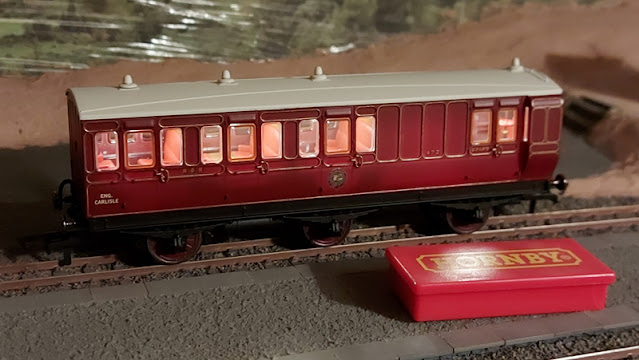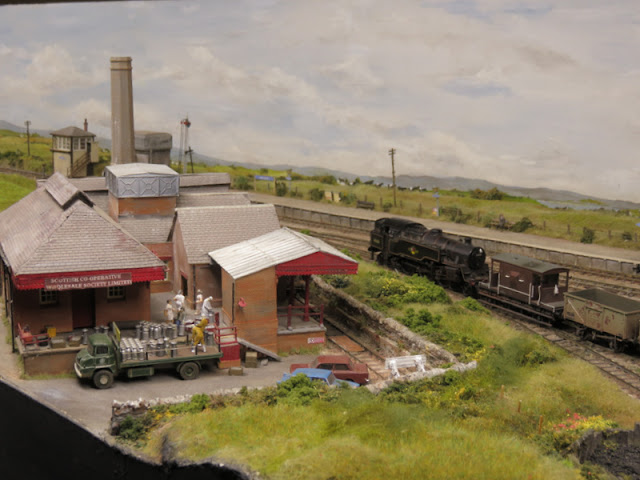A couple of weeks ago I went to the Uckfield exhibition. This is always a good show, with a high standard of layouts and good trade supports despite the modest venue, so I was happy to see it go ahead this year and am pleased to report the format and standard are as good as ever. Chris Ford noted some "fingerpoken", there were some running issues on a few layouts when I was there (Saturday morning) which I guess reflects this being the first show in a long time for most layouts. All the layouts were excellent, but here are a few of my favourites.
Axebridge (009) - Paul Windle
The only 009 layout present and Paul is a bit of a "frequent flyer" to this show having brought several layouts over the years. This little quayside looked nice with some operating potential too.
Clearwater Harbor (On30) - Steve Waterfield
This American NG layout has a really pleasing harbour scene and lots of detail, with frequent trains too. There may be a few of the usual HOn30 cliché's but there's plenty to engage the viewer.
A favourite feature of mine is working unloading, here the Bachmann side-tip cars are used to fill the barge, which even rocks gently in the water as the gravel tips in. However, the barge will take a while to fill since there's a flap in the bottom discharging it as fast as it fills!
Llawrglyn (EM) - Richard Loydall
Models of the Cambrian railway are rare, this mid-Wales might-have-been layout is set on that small pre-grouping operation. The superbly finished and lined loco along with the variety of wagons looked great in the open and understated scenery.
Wadebridge to Padstow (2mm finescale) - John Greenwood
We holidayed in Wadebridge a couple of years back, and as soon as I walked up to this model I recognised the town. This part of the station is now mostly supermarket and car park, but to the right the town centre and river bridge looked spot-on. The many buildings were finely modelled, the trains beautifully finished, and the track looked good too. Yet amazingly this is in 2mm scale.
And there is more too... as well as the accurate-looking model of Wadebridge, the track continued to another layout part, where it curved around an estuary over a bridge and into a model of Padstow. Here the details looked more unfinished, with some bare mock-up buildings and limited detail, but it still captured the atmosphere of the place. The river bridge is impressive, and the roll-up (canvas?) "water" novel and convincing, except a few places at the edge where it didn't sit right. Together these two stations made a large layout, built to a high standard.
Sherton Abbas (7mm scale, 31.5mm gauge finescale) - David Stone
It is not often that O gauge layouts are presented "cameo" style with a decent backscene and lighting, Sherton Abbas was not only presented well (other than the lighting failing to light the front of stock on the front siding - a common issue), but the scenery and composition worked really well too. Although GWR is not an unusual choice for a branch terminus, it was set in an earlier period which provided interesting trains, and very nicely modelled they were too.
Newton Heath Works (7mm scale, 31.25 and 16.2mm gauge finescale) - Mike Baker & Martin Finney
My favourite layout at the show was also 7mm scale, but it did include narrow gauge. Based on the Isle of Purbeck clay systems around Norden the model depicts clay being transferred from narrow to standard gauge, and a processing works. The layout is very simple, but the setting which incorporates elements from real locations is well composed, full of atmosphere, and well presented too. This layout won the Model Railway Journal "Cameo" competition, and I can see why.
It's another layout featuring working tipper trucks, here feeding a standard gauge wagon.
Both standard and narrow gauges have engine sheds. The buildings are all based on real ones, as is the unusual bridge carrying the NG over the SG, although they are taken from different places.
Overall a great show, and another encouragement that the exhibition circuit is slowly opening up post-Covid.
























































